California Mountain Kingsnake - Lampropeltis zonata
(Lockington ex Blainville, 1876)Description • Taxonomy • Species Description • Scientific Name • Alt. Names • Similar Herps • References • Conservation Status
 Red: Range of this species in California
Red: Range of this species in CaliforniaLampropeltis zonata - California Mountain Kingsnake
Range of similar species in California:
Orange: Lampropeltis multifasciata - Coast Mountain Kingsnake
Blue: Areas where mountain kingsnakes have been reported
but not confirmed or documented.
Click on the map for a topographical view
Map with California County Names
| All of the snakes shown on this page are the same species (unless they are shown as "Species Not Known"). The SSAR, whose list is followed by this website, has recognized that the species Lampropeltis zonata - California Mountain Kingsnake now consists of two species. (It was formerly was viewed as one species with several subspecies - Map.) The second species is Lampropeltis multifasciata - Coast Mountain Kingsnake. (No subspecies of the two species are recognized.) This page follows the two-species taxonomy but pictures of the snakes are organized in groups based on their former subspecies, to show the variation present in the species: Sierra Mountain Kingsnake Coast Mountain Kingsnake (north of Monterey Bay) Diablo Mountain Kingsnake |
|||||||||||||||||||||||||||||||||||||||||||||||||||
California Mountain Kingsnakes formerly recognized as |
|||||||||||||||||||||||||||||||||||||||||||||||||||
 |
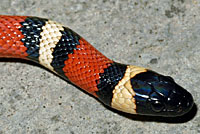 |
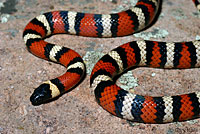 |
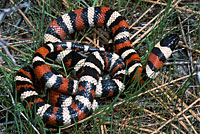 |
||||||||||||||||||||||||||||||||||||||||||||||||
| Adult Tuolumne County | Adult, Tuolumne County | ||||||||||||||||||||||||||||||||||||||||||||||||||
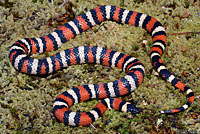 |
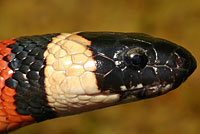 |
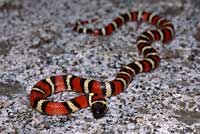 |
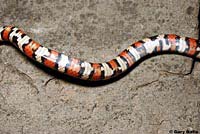 |
||||||||||||||||||||||||||||||||||||||||||||||||
| Adult Tuolumne County | Adult, Tuolumne County | Adult underside, Tuolumne County |
|||||||||||||||||||||||||||||||||||||||||||||||||
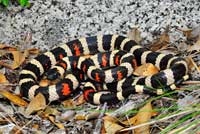 |
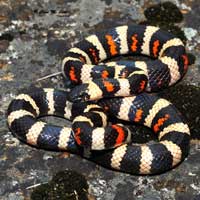 |
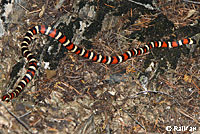 |
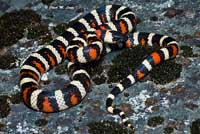 |
||||||||||||||||||||||||||||||||||||||||||||||||
| Adult, El Dorado County © Chad M. Lane | Adult photographed crawling in daylight, Plumas County. © Railfan | Adult, El Dorado County. © Chad M. Lane |
|||||||||||||||||||||||||||||||||||||||||||||||||
 |
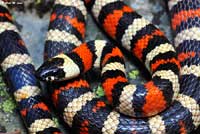 |
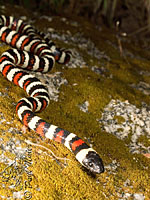 |
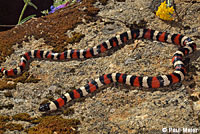 |
||||||||||||||||||||||||||||||||||||||||||||||||
| Adult, Calaveras County © Chad M. Lane | Adult, Mariposa County © Paul Maier | ||||||||||||||||||||||||||||||||||||||||||||||||||
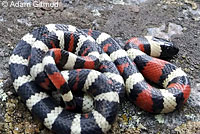 |
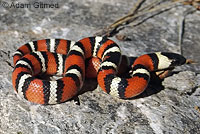 |
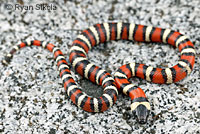 |
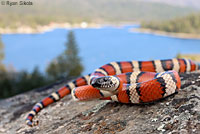 |
||||||||||||||||||||||||||||||||||||||||||||||||
| Juvenile, 3,700 ft. elevation Tuolumne County © Adam Gitmed |
Juvenile, 3,700 ft. elevation Tuolumne County © Adam Gitmed |
Adult, Madera County © Ryan Sikola | Adult, Madera County © Ryan Sikola | ||||||||||||||||||||||||||||||||||||||||||||||||
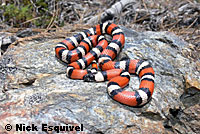 |
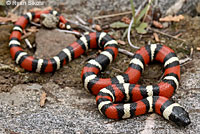 |
||||||||||||||||||||||||||||||||||||||||||||||||||
| Adult, Tuolumne County © Nick Esquivel | Adult, Greenhorn Mountains, Kern County © Ryan Sikola | ||||||||||||||||||||||||||||||||||||||||||||||||||
California Mountain KIngsnakes With Little or No Red Coloring |
|||||||||||||||||||||||||||||||||||||||||||||||||||
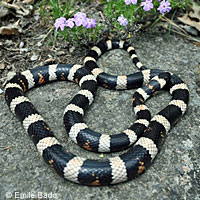 |
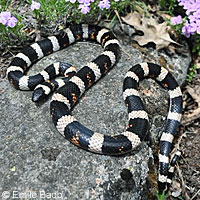 |
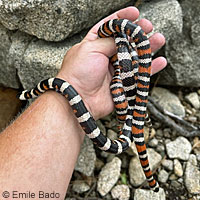 |
|||||||||||||||||||||||||||||||||||||||||||||||||
| "High Black" adult, Tuolumne County © Emile Bado | Adults, Tuolumne County © Emile Bado Left: "High Black" phase Right: Normal phase |
||||||||||||||||||||||||||||||||||||||||||||||||||
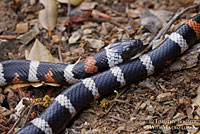 |
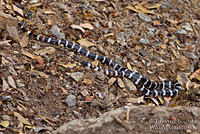 |
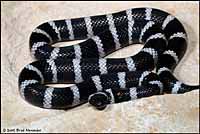 |
|||||||||||||||||||||||||||||||||||||||||||||||||
| This snake from Plumas County has little red coloring, with only a few complete red bands. © Timothy Boomer |
Axanthic adult, El Dorado County Specimen. Courtesy of Tim Burkhardt © 2002 Brad Alexander |
||||||||||||||||||||||||||||||||||||||||||||||||||
California Mountain Kingsnakes formerly recognized as |
|||||||||||||||||||||||||||||||||||||||||||||||||||
 |
|||||||||||||||||||||||||||||||||||||||||||||||||||
| Adult found on a driveway in Santa Cruz County © Scott Peden | |||||||||||||||||||||||||||||||||||||||||||||||||||
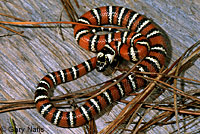 |
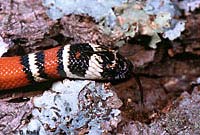 |
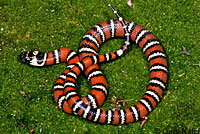 |
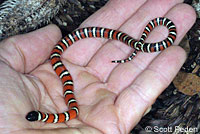 |
||||||||||||||||||||||||||||||||||||||||||||||||
| Juvenile, Santa Cruz Mountains, Santa Clara County | Juvenile, Santa Cruz County, found in January 2011 © Scott Peden | ||||||||||||||||||||||||||||||||||||||||||||||||||
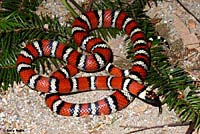 |
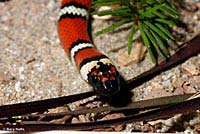 |
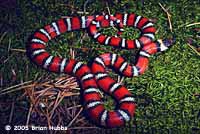 |
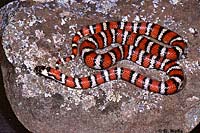 |
||||||||||||||||||||||||||||||||||||||||||||||||
| Adult, Santa Cruz Mountains, Santa Cruz County. © Gary Nafis Specimen courtesy of Mitch Mulks |
Adult, Santa Cruz Mountains, Santa Cruz County © 2005 Brian Hubbs | Adult, © Gary Nafis Specimen courtesy of Mitch Mulks |
|||||||||||||||||||||||||||||||||||||||||||||||||
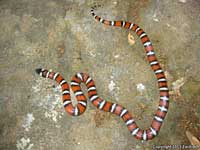 |
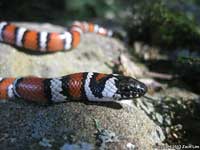 |
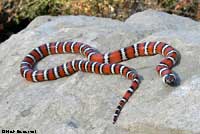 |
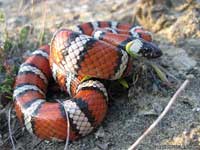 |
||||||||||||||||||||||||||||||||||||||||||||||||
| Adult, San Mateo County © Zachary Lim |
Adult, Santa Clara County © Nick Esquivel |
Adult, San Mateo County © Zachary Lim |
|||||||||||||||||||||||||||||||||||||||||||||||||
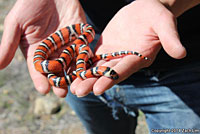 |
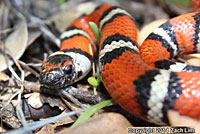 |
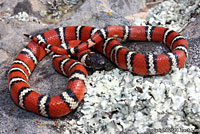 |
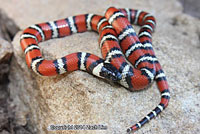 |
||||||||||||||||||||||||||||||||||||||||||||||||
| Adult, Santa Cruz County © Zachary Lim | Adult, Santa Cruz County © Zachary Lim | Adult, San Mateo County © Zachary Lim | |||||||||||||||||||||||||||||||||||||||||||||||||
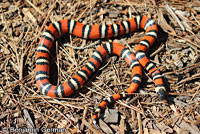 |
 |
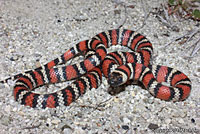 |
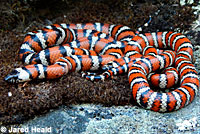 |
||||||||||||||||||||||||||||||||||||||||||||||||
| Adult, Santa Cruz County © Benjamin German |
Sometimes, this is all you get to see. San Mateo County. |
Adult, Santa Cruz County © Zachary Lim | These two adult males were found sheltering next to each other in Santa Clara County, both, strangely, with their hemipenes showing. © Jared Heald | ||||||||||||||||||||||||||||||||||||||||||||||||
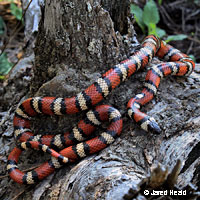 |
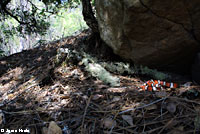 |
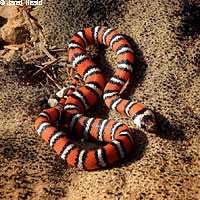 |
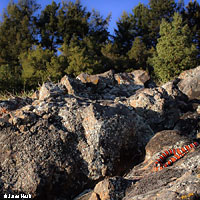 |
||||||||||||||||||||||||||||||||||||||||||||||||
| Adult, Santa Clara County © Jared Heald | Juvenile, Santa Cruz County © Jared Heald | ||||||||||||||||||||||||||||||||||||||||||||||||||
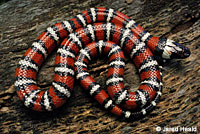 |
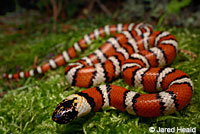 |
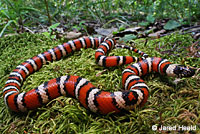 |
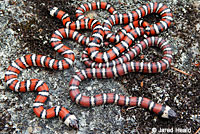 |
||||||||||||||||||||||||||||||||||||||||||||||||
| Adult, San Mateo County © Jared Heald | Adult, Santa Clara County © Jared Heald |
Adult, Santa Clara County © Jared Heald |
Adult, Santa Clara County © Jared Heald |
||||||||||||||||||||||||||||||||||||||||||||||||
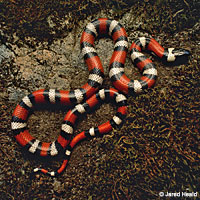 |
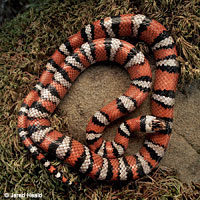 |
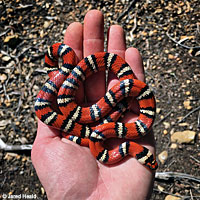 |
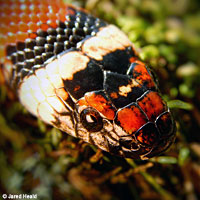 |
||||||||||||||||||||||||||||||||||||||||||||||||
| Adult with 22 triads from the Diablo Range, Santa Clara County © Jared Heald |
Adult with pinkish/orange coloring, Santa Cruz County © Jared Heald |
Adult with a lot of red on the head, Santa Cruz County © Jared Heald | |||||||||||||||||||||||||||||||||||||||||||||||||
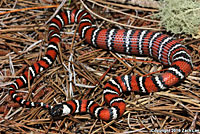 |
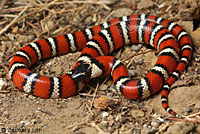 |
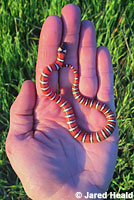 |
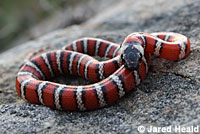 |
||||||||||||||||||||||||||||||||||||||||||||||||
| 12-inch-long juvenile with a recent meal, Santa Cruz County © Zachary Lim | Adult, San Mateo County © Zachary Lim | Neonate, San Mateo County © Jared Heald | |||||||||||||||||||||||||||||||||||||||||||||||||
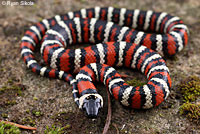 |
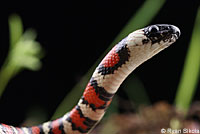 |
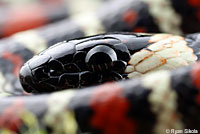 |
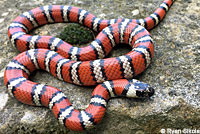 |
||||||||||||||||||||||||||||||||||||||||||||||||
| Adult, San Mateo County © Ryan Sikola | Adult, San Mateo County © Ryan Sikola | ||||||||||||||||||||||||||||||||||||||||||||||||||
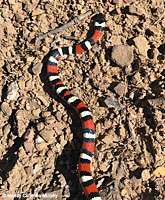 |
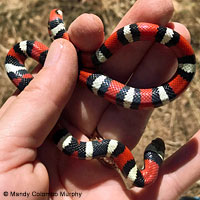 |
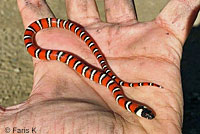 |
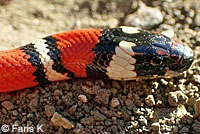 |
||||||||||||||||||||||||||||||||||||||||||||||||
| Young snake from 3,480 ft.elevation in the Ohlone Regional Wilderness in Alameda County © Mandy Colombo Murphy |
Sub-adult, San Mateo County © Faris K | ||||||||||||||||||||||||||||||||||||||||||||||||||
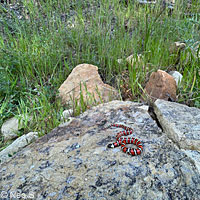 |
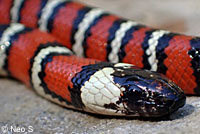 |
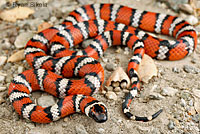 |
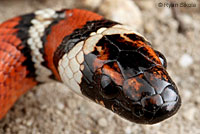 |
||||||||||||||||||||||||||||||||||||||||||||||||
| Adult, Santa Clara County © Neo S | Adult, Santa Cruz County © Ryan Sikola | ||||||||||||||||||||||||||||||||||||||||||||||||||
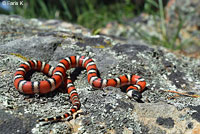 |
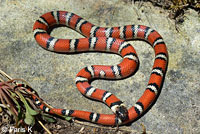 |
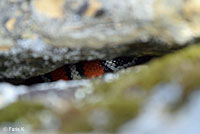 |
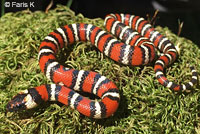 |
||||||||||||||||||||||||||||||||||||||||||||||||
| Adult, San Mateo County © Faris K | Adult, San Mateo County © Faris K | Adult, San Mateo County © Faris K | Adult, Santa Cruz County © Faris K | ||||||||||||||||||||||||||||||||||||||||||||||||
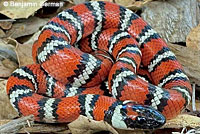 |
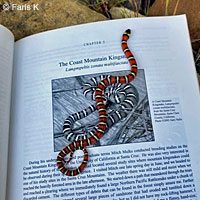 |
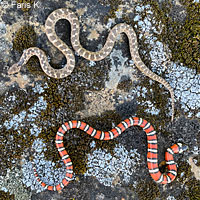 |
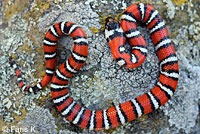 |
||||||||||||||||||||||||||||||||||||||||||||||||
| Adult, Santa Cruz County © Benjamin German |
This little well-read zonata was discovered in the Santa Cruz Mountains reading about itself in Brian Hubbs' book "Mountain Kings." © Faris K | Adult, Santa Cruz County, with an adult California Nightsnake, found nearby. © Faris K |
Juvenile with a fewbroken incomplete bands on the neck and body, San Mateo County © Faris K |
||||||||||||||||||||||||||||||||||||||||||||||||
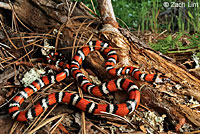 |
|||||||||||||||||||||||||||||||||||||||||||||||||||
| Adult, Santa Cruz County © Zach Lim | |||||||||||||||||||||||||||||||||||||||||||||||||||
California Mountain Kingsnakes in Kern County formerly recognized as |
|||||||||||||||||||||||||||||||||||||||||||||||||||
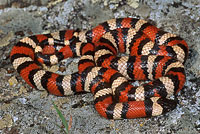 |
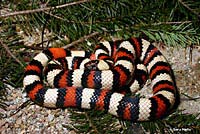 |
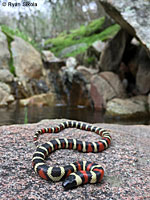 |
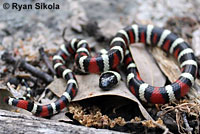 |
||||||||||||||||||||||||||||||||||||||||||||||||
| Adult, Kern County | Adult, Kern County © Gary Nafis Specimen courtesy of Mitch Mulks |
Adult, Kern County © Ryan Sikola | Adult, Kern County © Ryan Sikola | ||||||||||||||||||||||||||||||||||||||||||||||||
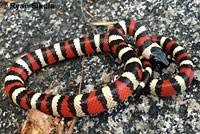 |
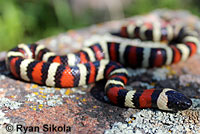 |
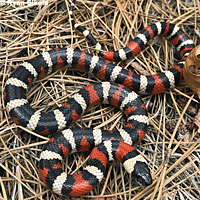 |
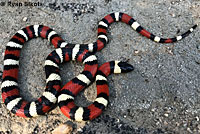 |
||||||||||||||||||||||||||||||||||||||||||||||||
| Adult, Kern County © Ryan Sikola | Adult, Kern County © Ryan Sikola | Adult, Kern County © Ryan Sikola | Adult, Kern County © Ryan Sikola | ||||||||||||||||||||||||||||||||||||||||||||||||
California Mountain Kingsnakes formerly recognized as |
|||||||||||||||||||||||||||||||||||||||||||||||||||
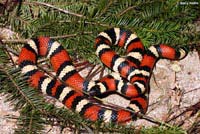 |
 |
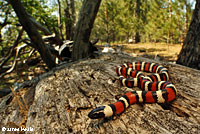 |
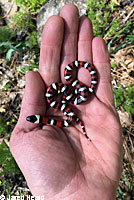 |
||||||||||||||||||||||||||||||||||||||||||||||||
| Adult, Diablo Range, Santa Clara County © Gary Nafis. Specimen courtesy of Mitch Mulks |
Juvenile, found at about 3,000 ft. elevation in Santa Clara County © Jared Heald | ||||||||||||||||||||||||||||||||||||||||||||||||||
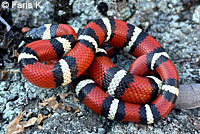 |
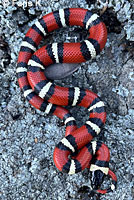 |
||||||||||||||||||||||||||||||||||||||||||||||||||
| Adult with 18 triads, Diablo Range, Santa Clara County © Faris K | |||||||||||||||||||||||||||||||||||||||||||||||||||
California Mountain Kingsnakes formerly recognized as |
|||||||||||||||||||||||||||||||||||||||||||||||||||
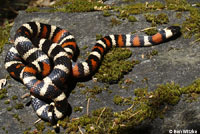 |
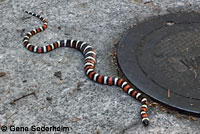 |
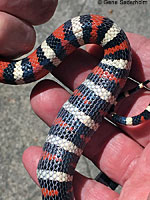 |
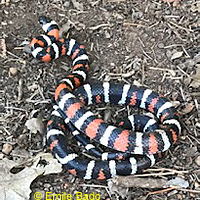 |
||||||||||||||||||||||||||||||||||||||||||||||||
| Adult from Trinity County © Ben Witzke (Formerly recoginzed as an intergrade of L. z. zonata and L. z. multicincta) |
Young adult with a recent meal inside it, Siskiyou County © Gene Sederholm | Gravid adult female, Shasta County © Emile Bado |
|||||||||||||||||||||||||||||||||||||||||||||||||
Species Not Known |
|||||||||||||||||||||||||||||||||||||||||||||||||||
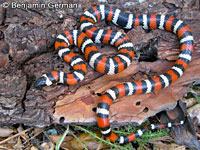 |
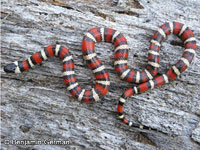 |
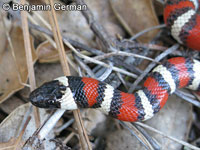 |
|||||||||||||||||||||||||||||||||||||||||||||||||
| Adult, Gabilan Mountains, San Benito County © Benjamin German |
Juvenile, Gabilan Mountains, San Benito County © Benjamin German |
||||||||||||||||||||||||||||||||||||||||||||||||||
| California Mountain Kingsnakes Feeding | |||||||||||||||||||||||||||||||||||||||||||||||||||
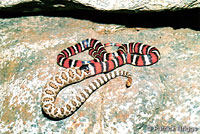 |
 |
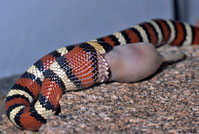 |
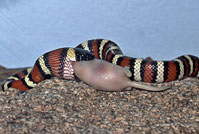 |
||||||||||||||||||||||||||||||||||||||||||||||||
| An adult California Mountain Kingsnake eating a juvenile Northern Pacific Rattlesnake in Fresno County. © Patrick Briggs |
A captive juvenile California Mountain Kingsnake eating a hairless juvenile mouse. | ||||||||||||||||||||||||||||||||||||||||||||||||||
| Habitat | |||||||||||||||||||||||||||||||||||||||||||||||||||
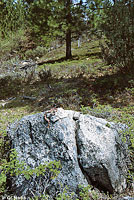 |
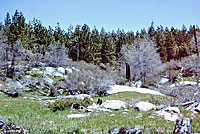 |
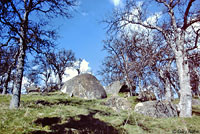 |
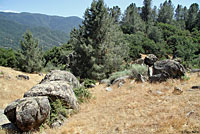 |
||||||||||||||||||||||||||||||||||||||||||||||||
| Habitat, Tuolumne County |
Habitat, Tuolumne County |
Habitat, Kern County | Habitat, Kern County | ||||||||||||||||||||||||||||||||||||||||||||||||
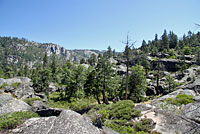 |
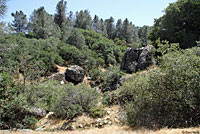 |
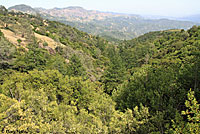 |
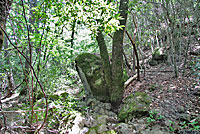 |
||||||||||||||||||||||||||||||||||||||||||||||||
| Habitat, Tuolumne County | Habitat, Kern County | Habitat, Napa County | Habitat, Napa County | ||||||||||||||||||||||||||||||||||||||||||||||||
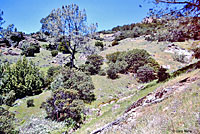 |
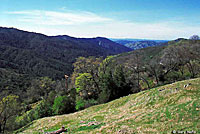 |
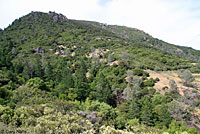 |
|||||||||||||||||||||||||||||||||||||||||||||||||
| Habitat, Napa County |
Habitat, Mayacamas Mountains, Sonoma County |
Habitat, Napa County | |||||||||||||||||||||||||||||||||||||||||||||||||
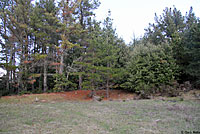 |
 |
 |
 |
||||||||||||||||||||||||||||||||||||||||||||||||
| Habitat, 2,500 ft. Santa Cruz Mountains, Santa Clara County | Habitat, 1,400 ft. Santa Cruz Mountains, Santa Cruz County | Habitat, Santa Cruz Mountains, Santa Cruz County |
Habitat, Santa Cruz Mountains © Zachary Lim |
||||||||||||||||||||||||||||||||||||||||||||||||
 |
 |
 |
 |
||||||||||||||||||||||||||||||||||||||||||||||||
| Habitat, San Mateo County | Habitat, San Mateo County © Zachary Lim |
Habitat, San Mateo County © Zachary Lim |
Habitat, Santa Cruz Mountains © Zachary Lim |
||||||||||||||||||||||||||||||||||||||||||||||||
| Short Videos | |||||||||||||||||||||||||||||||||||||||||||||||||||
 |
 |
||||||||||||||||||||||||||||||||||||||||||||||||||
| A short look at a juvenile of the nearly-identical species Coast Mountain Kingsnake found under a rock. (These are still considered to be the same species by many herpers.) | This California Mountain Kingsnake was found in the wild eating a Western Red-tailed Skink in Kern County © Ryan Sikola |
||||||||||||||||||||||||||||||||||||||||||||||||||
|
|||||||||||||||||||||||||||||||||||||||||||||||||||
|
|||||||||||||||||||||||||||||||||||||||||||||||||||
|
The following conservation status listings for this animal are taken from the April 2024 State of California Special Animals List and the April 2024 Federally Listed Endangered and Threatened Animals of California list (unless indicated otherwise below.) Both lists are produced by multiple agencies every year, and sometimes more than once per year, so the conservation status listing information found below might not be from the most recent lists. To make sure you are seeing the most recent listings, go to this California Department of Fish and Wildlife web page where you can search for and download both lists: https://www.wildlife.ca.gov/Data/CNDDB/Plants-and-Animals. A detailed explanation of the meaning of the status listing symbols can be found at the beginning of the two lists. For quick reference, I have included them on my Special Status Information page. If no status is listed here, the animal is not included on either list. This most likely indicates that there are no serious conservation concerns for the animal. To find out more about an animal's status you can also go to the NatureServe and IUCN websites to check their rankings. Check the current California Department of Fish and Wildlife sport fishing regulations to find out if this animal can be legally pursued and handled or collected with possession of a current fishing license. You can also look at the summary of the sport fishing regulations as they apply only to reptiles and amphibians that has been made for this website. |
||
| Organization | Status Listing | Notes |
| NatureServe Global Ranking | None | |
| NatureServe State Ranking | None | |
| U.S. Endangered Species Act (ESA) | None | |
| California Endangered Species Act (CESA) | None | |
| California Department of Fish and Wildlife | None | |
| Bureau of Land Management | None | |
| USDA Forest Service | None | |
| IUCN | None | |
|
|
||
Return to the Top
© 2000 -





